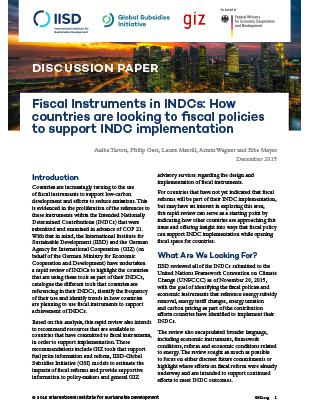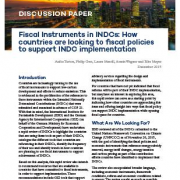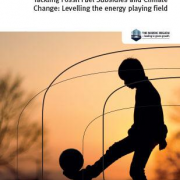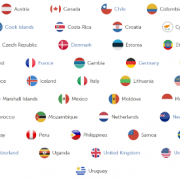Economic Instruments, Fossil Fuel Subsidies and Climate Change
16 February 2016—Geneva—The Global Subsidies Initiative (GSI) of the International Institute for Sustainable Development (IISD) hosted a webinar on the climate change impacts of USD 500 billion of government subsidies to fossil fuels. The webinar was chaired by Peter Wooders, Group Director, Energy, IISD, who outlined the importance of fiscal instruments and mitigation efforts in light of the UNFCCC agreement and the ambitious efforts of the Friends of Fossil Fuel Subsidy Reform in promoting an international communiqué on the issue.

Laura Merrill, Senior Researcher, GSI, explained the link between economic instruments—including fossil fuel subsidies, transport fuel duties and carbon taxes—and the potential from a combination of these measures to lower global emissions by around 23 per cent as against business-as-usual (BAU). This effort would liberate around USD 3 trillion in savings and revenues to governments. Merrill focused on research undertaken by the GSI with support from the Nordic Council of Ministers across 20 countries that finds on average governments save USD 93 per tonne of CO2e abated from fossil fuel subsidy reform (FFSR). Moreover, reform would lead to average national emissions reductions of around 11 per cent, which could improve to 18 per cent with a modest reinvestment of savings (30 per cent) into renewables and energy efficiency. Merrill also outlined the opportunities in the new Paris climate change agreement for links to economic instruments and their emissions mitigation potential, such as FFSR. This includes insertion of the issue within Intended Nationally Determined Contributions (INDCs), as well as opportunities for transparency and capacity building.
Satryo B. Brotodiningrat, First Secretary, Permanent Mission of the Republic of Indonesia to the UN, WTO and other International Organization in Geneva, discussed Indonesia’s INDC. He highlighted that Indonesia planned for emissions reductions against BAU of 29 per cent by 2030. Indonesia is aiming for at least 23 per cent of energy use from renewable resources by 2025. Brotodiningrat explained how the government has reallocated diesel and gasoline subsidies totalling approximately USD 16 billion toward productive sectors and social programs, such as health care and education. Of this amount, USD 2.5 billion has been earmarked for infrastructure, USD 1.2 billion for roads and ports, and to enable a doubling of government investment in renewable energy.
Ivetta Gerasimchuk, Senior Researcher, GSI, explained the size of producer subsidies, estimated at around USD 100 billion worldwide (USD 78 billion in the G20) in comparison to the size of consumer subsidies (estimated at around USD 490 billion in 2014). Such subsidies to the extraction of oil, gas and coal—for example via tax and royalty breaks—can unlock fields that otherwise would not be economically viable and thus release “unburnable carbon” into the atmosphere.

Philip Gass, Senior Researcher, IISD, then shared next steps in moving from INDCs towards implementation, and IISD’s role in supporting countries to identify (and apply for) bankable projects with financing organizations and donors. FFSR contributes by enabling a level energy playing field for new sustainable energy entrants, and in terms of policy coherence on energy and climate change.
The webinar also included questions from the audience. There were a number of questions including around the 13 countries that have included FFSR within INDCs which. Although 13 countries may seem modest, the number of countries could likely grow in the years to come and is not to be taken as an indicator of the numbers of countries actually implementing FFSR. Questions were also asked about the practicality of government hypothecation and ring-fencing of funds for productive and social investments. Brotodiningrat explained that such changes had been planned in Indonesia for a number of years, but it was only recently possible with reform in fuel subsidies, which has enabled a redirection of funds toward government priorities. Further questions covered the modelling developed to measure the emissions reductions from the use of fiscal instruments such as FFSR. To this end, GSI has developed an integrated fiscal model (the GSI-IF model)—more information can be found in GSI research on the topic. With further questions around the FFSR agenda for 2016, participants agreed that it will be a year of implementation at the domestic level, which will also see further building on initiatives such as the Friends of Fossil Fuel Subsidy Reform communiqué.
Related Reports:

On fiscal instruments within INDCs; available here.

On the link between consumer subsidies and climate change: available here.

To join the Friends of Fossil Fuel Subsidy Reform Communiqué, click here.
Recording:
Recording and slides from the webinar: available here. Running time one hour.
